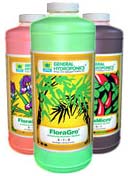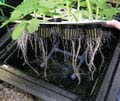Nutrients for Hydroponic systems
Hydroponic nutrients can be a complex issue or as simple as mixing and pouring. Anyone not familiar with hydroponic nutrients should just stick with a proven formula from a reputable manufacture, and simply fallow the directions on the container. This will let you learn the basics of growing hydroponically before experimenting.
However a lot of off the shelf hydroponic nutrients can be expensive, costing upwards of $0.30 +cents per gallon of nutrient solution, or more. But there are nutrient manufactures that sell cost effective nutrients. Even down to as low as less than 2 cents per gallon of nutrient solution. We have a list of some of these cost effective nutrient manufactures for you. Feel free to contact us if you know of more we can add to the list so we can share them as well.
Nutrients are one of the basics of any hydroponic system. In order for a fertilizer to be incorporated into a hydroponic system it must be soluble in water. If not, the plant cannot access it. With Hydroponics the grower has complete control over the implementation of fertilizer, regarding type and concentration. They also have the ability to immediately monitor and maintain a relative consistency, provided a nutrient meter is available. The composition of the nutrients is important and there are over twenty elements that are needed for a plant to grow. Carbon, hydrogen and oxygen are absorbed from the air and water.
The rest of the elements, called mineral nutrients, are dissolved in the nutrient solution and need to be in the correct ratios. Any good Hydroponic nutrient should contain all of these elements; Nitrogen (N), Potassium (K), Phosphorous (P), Calcium (Ca), Magnesium (Mg), Sulphur (S), Iron (Fe), Manganese (Mn), Copper (Cu), Zinc (Zn), Molydenum (Mo), Boron (B), Chlorine (Cl). For the most part, this is taken care of with any pre-formulated commercial hydroponic nutrients. Often, these pre-made nutrients come in 1, 2, 3, or even more “parts” so the grower can change the ratio of the mineral elements to allow for either vegetative or fruiting and flowering growth, or for different crops. It is best for the beginner to just fallow the general directions before experimenting with changing the ratios.
Be sure to use nutrients designed for Hydroponics in a Hydroponic system. The composition of elements in nutrients designed for soil are very different from that for Hydroponics because soil grown plants get most of these elements from the soil. With Hydroponics there is no soil to get the elements from, so the two are very different in composition because they are not designed to be a complete plant food and they may not water-soluble. For example, Nitrogen in the form of urea is not immediately available to a plant in hydroponics because urea is not soluble in water. For this reason Nitrogen must be delivered in its Nitrate form in order to be utilized in hydroponics.
One thing that is often over looked when it comes to nutrients is the nutrient solution temperature. The roots of plants grow underground in nature and to duplicate what they would receive in nature it is very important to keep the root zone to 68-72 degrees. That's not to say if the nutrient temp reaches 73 or 74 the plants will die, but it should be kept as close to 68-72 degrees as you can. Plants with nutrient tempters too high can have problems including (but not limited to) flowers turning yellow and falling off, damaged fruits and a lack of new growth.




